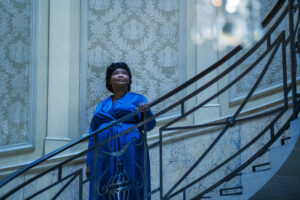
Octavia Spencer as Madam C. J. Walker in “Self Made,” the Netflix series.
When “Self Made: Inspired by the Life of Madam C. J. Walker” — the Netflix series starring Oscar winner Octavia Spencer — premieres on March 20, millions of people around the world will hear Madam Walker’s name for the first time. Thousands of people, who already know at least a little bit about her, will tune in with hopes of learning something new.
I can tell from the reaction on social media that there’s an audience hungry for a story of black women’s empowerment and African American success. There’s also a core group of Madam Walker fans who wrote elementary school reports about her and cosmetologists who followed in her footsteps. They have been waiting for decades for this particular tale. The excitement reminds me of the 1950s and 1960s when those of us of a certain age ran to our televisions on the rare occasions when a black person appeared on The Ed Sullivan Show or when Nat King Cole finally hosted a show in 1956. Of course, in 2020, we have many other viewing options, but as Walker’s biographer and great-great-granddaughter, I’ve come to know how attached many people feel and how personally they identify with anything related to Madam Walker. It’s wonderful to see so much interest and anticipation. In the last few weeks, I’ve received more than the usual number of speaking engagement requests and noticed the announcements of premiere night viewing parties.
But long before Hollywood came calling, many people recognized the power of Madam Walker’s story and identified with her struggles. The seeds that were planted decades ago are in full bloom. A century after her death, Madam Walker is having a moment.
In 1955, I felt my first moment of Walker magic when I opened my grandmother’s dresser drawer and found miniature mummy charms and receipts from the 1922 trip my great-grandmother, A’Lelia Walker took to Cairo. 
I was only three years old and had no idea that that discovery would lead me to write, The Joy Goddess of Harlem: A’Lelia Walker and the Harlem Renaissance, a biography that will be published by Scribner in 2021.
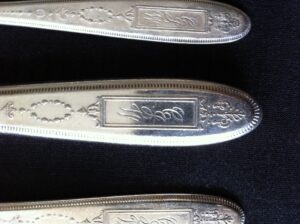 When I was a toddler eating dinner with my parents, there was no way for me to know that our silverware — with its “CJW” monogram — would inspire four books, including On Her Own Ground: The Life and Times of Madam C. J. Walker, the biography that provided the factual material for the fictionalized four-part Netflix series.
When I was a toddler eating dinner with my parents, there was no way for me to know that our silverware — with its “CJW” monogram — would inspire four books, including On Her Own Ground: The Life and Times of Madam C. J. Walker, the biography that provided the factual material for the fictionalized four-part Netflix series.
For the 2020 edition — available for pre-order now! with a publication date of March 24 — I’ve written a new epilogue and made a few revisions. I also recorded an audio book which already is available. The book temporarily has been renamed Self Made to tie in with the series promotion.

There are many events and initiatives during the last 50 years that have set the stage for this moment.
I wrote my first report about A’Lelia Walker in 1970 when I was a senior in high school. As a student at Columbia University’s Graduate School of Journalism in 1975, I was encouraged by Professor Phyl Garland to write my master’s paper about Madam Walker. At the time, there still was no major biography of Madam Walker or A’Lelia Walker.
Stanley Nelson’s 1987 “Two Dollars and a Dream,” was the first documentary about Madam Walker. Nelson, whose grandfather Freeman B. Ransom was general manager and general counsel for the Madam C. J. Walker Manufacturing Company, also directed and produced “BOSS: The Black Experience in Business” a 2019 nonfiction film that includes historically accurate information about Madam Walker.
Here’s the transcript and the video.
 In 1982, Alex Haley, whose fame from the 1976 Roots miniseries still was cresting, approached us about producing a Madam Walker project. For the next several years, Alex was a helpful mentor as I traveled to more than a dozen American cities doing primary source research and interviewing nearly 20 people who had known, worked with or been friends of Madam Walker and A’Lelia Walker.
In 1982, Alex Haley, whose fame from the 1976 Roots miniseries still was cresting, approached us about producing a Madam Walker project. For the next several years, Alex was a helpful mentor as I traveled to more than a dozen American cities doing primary source research and interviewing nearly 20 people who had known, worked with or been friends of Madam Walker and A’Lelia Walker.
On a freighter trip from Long Beach, California to Guyaquil, Ecuador with Alex and two other writers, I finished the manuscript for Madam C. J. Walker: Entrepreneur, a young adult biography published in 1991.
It’s stunning to think this was the first book length biography of Madam Walker ever published, especially now that my personal library is filled with more than 200 books that chronicle Madam Walker’s life from Tiffany Gill’s Beauty Shop Politics, Noliwe Rooks’s Hair Raising and Kathy Peiss’s Hope in a Jar to Hillary and Chelsea Clinton’s The Book of Gutsy Women, Jean Case’s Be Fearless and The Undefeated’s The Fierce 44.

Madam Walker Books in my personal library
And the scholarship continues. Indiana University professor Tyrone McKinley Freeman’s Madam C. J. Walker’s Gospel of Giving: Black Women’s Philanthropy during Jim Crow will be published in November. Since the 1970s, many people have worked together on a range of initiatives to preserve Madam Walker’s legacy. Among the projects:
a campaign for the 1998 Madam Walker U. S. postage stamp
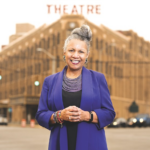
restoration of the Madam Walker Legacy Center in Indianapolis
designation of Villa Lewaro as a National Trust for Historic Preservation National Treasure
digitization of more than 40,000 items in the Madam Walker Collection at the Indiana Historical Society where a 16 month Madam Walker exhibition — You Are There: Madam Walker 1915 –– opened in September 2019

A’Lelia Bundles and Richelieu Dennis, founding CEO of Sundial Brands
renaming of 136th Street at the corner of Malcolm X Boulevard (Lenox Avenue) as Madam C. J. Walker and A’Lelia Walker Place in July 2019
creation of the Madam Walker Family Archives, the largest privately owned collection of Walker records, photographs and memorabilia
dozens of Madam Walker dolls and amazing fine art like Sonya Clark’s large installation at the Austin’s Blanton Museum and Indianapolis’s Alexander Hotel

MCJW, the Madam Walker line of hair care products created by Sundial Brands.
introduction of MCJW, a new line of Madam Walker hair care products manufactured by Sundial Brands and sold exclusively at Sephora.
So, yes, the Netflix series will introduce Madam Walker to many people who otherwise would never have known about her. After you’ve watched the Hollywood version — where the writers have used a great deal of creative license to heighten the drama with characters who didn’t exist and scenes that didn’t occur in real life — we hope you will become curious enough to seek the facts. And of course we hope you will make your way to the new edition of On Her Own Ground as well as some of the blogs about Madam Walker and A’Lelia Walker on this website. There’s also a new audio book that I recorded a few weeks ago.
For updates on all our Madam Walker projects, please visit our Madam Walker Website and follow us on Twitter and Instagram. Click here to sign up for our newsletter.
A’Lelia Walker was born 134 years ago today on June 6, 1885.
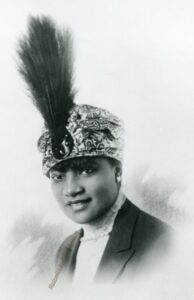 I’ve written a lot about her since I began researching her life during my senior year in high school fifty years ago. I won’t rehash the basic biographical information, which you can find in my book, On Her Own Ground: The Life and Times of Madam C. J. Walker, and in blog articles like “A’Lelia Walker’s 1924 Visit to Atlantic City” and “A’Lelia Walker Meets Ethiopian Empress Zauditu” on my website.
I’ve written a lot about her since I began researching her life during my senior year in high school fifty years ago. I won’t rehash the basic biographical information, which you can find in my book, On Her Own Ground: The Life and Times of Madam C. J. Walker, and in blog articles like “A’Lelia Walker’s 1924 Visit to Atlantic City” and “A’Lelia Walker Meets Ethiopian Empress Zauditu” on my website.
What I’d like to do today in celebration of her birthday is talk about the person I’ve discovered through extensive research – including her personal correspondence and other primary source documents – rather than the caricature that a number of authors have created.
First and foremost, she will always be known as the daughter of Madam C. J. Walker, the early 20th century hair care entrepreneur and philanthropist. But she also was her own person with interests, personality traits, likes, dislikes and a fascinating circle of friends.
More than I knew when I wrote On Her Own Ground twenty years ago, she was very much a patron of the arts with her own strong passion for music and art that began when she was growing up in St. Louis during the ragtime era of the 1890s. She traveled internationally and understood current events and the politics of Jim Crow. She had an impresario’s instinct for staging extravagant events.
She was a fashion trendsetter with a sharp eye for design. Her parties helped define the Harlem Renaissance. Her Dark Tower cultural salon was legendary. While she was less directly engaged than her mother in causes like the anti-lynching and women’s club movements, she raised money for community and social service organizations.
How Other Authors Viewed A’Lelia Walker
My literary introduction to A’Lelia Walker was through Langston Hughes’s The Big Sea, in which he famously proclaimed her death in August 1931 to be the end of an era. “That was really the end of the gay times of the New Negro era in Harlem,” he wrote. It is Hughes who anointed her “the joy goddess of Harlem’s 1920s” because of her parties and her room-filling personality.
 What I have discovered after decades of research, however, is that several other authors who did not know her have repeated second hand, inaccurate and entirely fabricated stories about her. It’s hard to resist wondering if some of them have a need to project a story line onto her life. In their speculation and their failure to do original research, they have relied upon stereotypes and clichés about what they imagine A’Lelia Walker might have done.
What I have discovered after decades of research, however, is that several other authors who did not know her have repeated second hand, inaccurate and entirely fabricated stories about her. It’s hard to resist wondering if some of them have a need to project a story line onto her life. In their speculation and their failure to do original research, they have relied upon stereotypes and clichés about what they imagine A’Lelia Walker might have done.
I very much admire David Levering Lewis’s Pulitzer Prize-winning scholarship on W.E.B. DuBois, but his description of A’Lelia Walker in his widely read When Harlem Was in Vogue set the stage for a great deal of misinformation about her. Just as I discovered while doing research for my four Madam Walker books, I have encountered the same fictionalization of A’Lelia Walker while researching The Joy Goddess of Harlem: A’Lelia Walker and the Harlem Renaissance (forthcoming from Scribner). In all her complexity and contradictions, A’Lelia Walker is an original who needs no embellishment.
I won’t address all the myths today, but here are three of the most glaring.
The Myth of A’Lelia Walker’s Short Attention Span
In 1982 Lewis wrote: “Her intellectual powers were slight. After seven minutes, conversation went precipitously downhill, but those first seven minutes were usually quite creditable.” Among the many authors who have mentioned A’Lelia Walker since then, Steven Watson perpetuated this myth in his 1995 book, The Harlem Renaissance, when he wrote: “One acquaintance cattily declared seven minutes to be her limit for elevated conversation.”
I’ve always found this claim odd. During the early 1980s, I had the good fortune of interviewing a dozen or so of A’Lelia Walker’s octogenarian and nonagenarian friends who regaled me with stories of their social gatherings and travels. To a person, they described A’Lelia’s attention to detail for the elegant parties she orchestrated. I know from her letters how focused she could be when she cared about something. I can’t help but wonder if, by chance, someone actually said she had a seven-minute attention span, that that person may have been someone she didn’t like or with whom she didn’t wish to have a conversation. She could be like that when she wanted to.
The Myth that A’Lelia Walker Didn’t Read Books
Watson seems to have started this rumor when he wrote: “Although she supported Harlem culture, she had little interest in intellectual talk and rarely read books.” More recently Saidiya Hartman paraphrased Watson and others in her 2019 book when she wrote: “[S]he financed the Dark Tower, a literary salon in her palatial home of thirty rooms, although it was rumored that she never read books, only supported their authors.” (The Dark Tower, by the way, was in A’Lelia Walker’s 136th Street townhouse rather than in Villa Lewaro, her Irvington, New York mansion.) Neither Watson or Hartman cites a source for this claim.
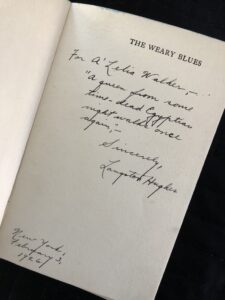
 In fact, I have many books from A’Lelia Walker’s personal library, including an autographed copy of Langston Hughes’s The Weary Blues. I also have personal correspondence in which she thanks friends for books they have sent her and talks about how much she loves to read.
In fact, I have many books from A’Lelia Walker’s personal library, including an autographed copy of Langston Hughes’s The Weary Blues. I also have personal correspondence in which she thanks friends for books they have sent her and talks about how much she loves to read.
The Myth that Grace Nail Johnson Wouldn’t Socialize with A’Lelia Walker
One of the most memorable passages in Lewis’s When Harlem Was in Vogue is this: “Not everybody pined for an invitation to her brownstones and her country place. Grace Nail Johnson, the wife of James Weldon Johnson and ‘social dictator’ of Harlem, would as soon have done the Black Bottom on Lenox Avenue as cross A’Lelia’s threshold.”
These sentences have taken on a life of their own in Harlem Renaissance lore and been accepted as factual by readers and authors who have interpreted it to mean that A’Lelia Walker was shunned by Grace Nail Johnson and Harlem’s black elite.
In August 1999 Sondra Kathryn Wilson, the executor of the Johnson estate, told me in an email message that Mrs. Johnson was quite upset about this portrayal.
“It’s a lie,” she told Dr. Grace Sims Okala, her adopted daughter, in an interview recorded some years earlier by Wilson. “Grace and Jim considered the older Mrs. Walker as their friend. Grace often said that the elder Mrs. Walker and her father had similar backgrounds…Grace and Jim didn’t attend a lot of parties. Jim traveled a lot. He was gone so much and when he was home, he was writing. Grace and Jim preferred small dinner parties. If Grace didn’t attend the younger Ms. Walker’s parties, it had nothing to do with Ms. Walker. I know she wouldn’t attend a party if Jim was away. She wouldn’t have gone to Mrs. Walker’s or any other party alone.”
And I know from A’Lelia Walker’s correspondence – including an invitation for an event that lists both A’Lelia Walker and Grace Nail Johnson as hosts – that the speculation about their estrangement is inaccurate. Among other things, the spirit and implication of the story are contradicted by what society columnist Gerri Major, singer Alberta Hunter, artist Romare Bearden and many others told me about A’Lelia Walker during the 1980s.
There is so much more to say about my great-great-grandmother and namesake. Stay tuned for The Joy Goddess of Harlem.
On Sunday morning, May 25, 1919 – exactly 100 years ago this weekend – Madam C. J. Walker died at Villa Lewaro, her Irvington-on-Hudson, New York estate.
A few hours later in black churches across America, ministers talked of her journey from deep poverty in the cotton fields of Delta, Louisiana to president of the international Madam C. J. Walker Manufacturing Company. It was such big news that the announcement also was made at a Negro League baseball game in Chicago that afternoon.

Madam C. J. Walker died on May 25, 1919 at Villa Lewaro, her Irvington, NY estate.
She was born Sarah Breedlove on December 23, 1867 on the same plantation where her parents and older siblings had been enslaved before the end of the Civil War. The first child in her family born into freedom, she would become a millionaire who bequeathed more than $100,000 to her community, including $5,000 to the NAACP’s anti-lynching fund.
By providing job opportunities for the nearly 20,000 sales agents and beauty culturists who sold her Wonderful Hair Grower, she helped them become economically independent. She used her wealth and influence as a philanthropist, patron of the arts and political activist to support black institutions and organizations.
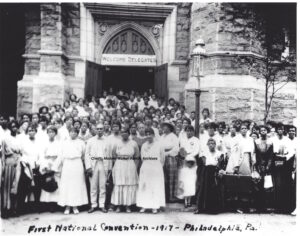
Madam Walker at her first national convention of her sales agents and beauty culturists in 1917.
At her 1917 national convention, she told the delegates that their “first duty” as Walker associates “was to humanity.” During the final session, she and her agents dispatched a telegram to President Woodrow Wilson urging him to support legislation to make lynching a federal crime.
Madam Walker’s funeral on May 30 was a dignified gathering with pallbearers who represented black America’s most prominent civil rights, business and religious leaders. Walker Company employees and agents filed quietly and reverently past her casket in the music room at Villa Lewaro as J. Rosamond Johnson sang “Since You Went Away,” the spiritual he had composed with his brother, James Weldon Johnson.
This year as we observe the centennial of Madam Walker’s death, there is much to remind us of the powerful inspiration her legacy still provides.
Throughout 2019 and 2020 we’ll celebrate with several events including
*the launch of new products in Sundial’s MCJW hair care line at Sephora.com

MCJW, the Madam Walker line of hair care products created by Sundial Brands.
*the re-opening of the renovated Madam Walker Legacy Center in Indianapolis
*the September 19 opening of a Madam Walker exhibition at the Indiana Historical Society in Indianapolis
*the renaming this summer of 136th Street between Lenox and Seventh Avenue in Harlem
*the digitization of 40,000 items from the Madam Walker Collection of letters, photographs, business records and ephemera at the Indiana Historical Society
This spring we’ve already had help celebrating with
*a featured segment about Madam Walker in Stanley Nelson’s PBS documentary, “BOSS: The Black Experience in Business”
*Harlem Eat Up Luminary Award to Madam Walker
*”What Madam Taught Us” in the May issue of Essence
*AAIHS’s five-part Black Perspectives blog forum with articles by scholars who bring new perspectives on Madam Walker’s life
*Our interview with Georgia Public Broadcasting’s Morning Edition host Leah Fleming
ABC News Now’s segment about Villa Lewaro
Ronda Racha Penrice’s NBC BLK feature on Madam Walker
During the last four decades in my role as Madam Walker’s biographer, it has been a joy for me to share her story with a range of audiences from elementary school students and Harvard Business School classes to corporate CEOs and women in the college course at Bedford Hills Correctional Facility.
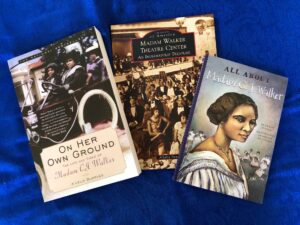
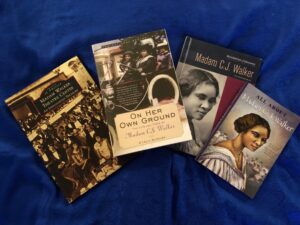
Madam Walker biographies by A’Lelia Bundles
I’m grateful that my book, On Her Own Ground: The Life and Times of Madam C. J. Walker (Scribner/Lisa Drew 2001), is considered the most reliable source for accurate information about Madam Walker and that elementary school students can learn about her in All About Madam C. J. Walker (Cardinal/Blue River Press 2018).
Knowing that Villa Lewaro soon will become a think tank for women of color entrepreneurs under the auspices of the New Voices Foundation brings the story full circle just as Madam Walker dreamed when she moved into the house in 1918.
Follow us on Twitter at @aleliabundles @mcjwbeauty @madamcjwalker
Follow us on Instagram at @aleliabundles @mcjwbeauty
A’Lelia Bundles is Madam C. J. Walker’s great-great-granddaughter and biographer.

My dad, S. Henry Bundles, Jr., died a few days ago on March 26.
Since then I’ve had a few tears, of course, but at the moment I am feeling more grateful than sad because he lived 92 very beautiful and productive years.
He was president of the Center for Leadership Development in Indianapolis from 1977 to 2000, a community leader, an institution builder and a fantastic father.
My brothers, Lance and Mark, and I are so fortunate to have had his love and guidance for so many decades. “He was a good father and a good man, who loved his children unconditionally,” Lance reminded me as we began to process our loss.

At Daddy’s 65th Birthday Party in 1992
I called him every Sunday morning at precisely 11:30 a.m. I knew he was waiting by the phone and I knew he would say, “Hello to the world’s greatest daughter!”
I truly will miss that cheerful greeting.
Daddy was born on February 15, 1927 in Indianapolis, the seventh of Mary Ellis Davis and S. Henry Bundles, Sr.’s nine children. He graduated from Crispus Attucks High School in 1943 when he was 16 years old. A 1948 graduate of Indiana University, he is believed to be the first black student to earn a degree from IU’s School of Journalism. It was a sign of the times that despite this degree and his experience as a photographer and reporter during his stint in the Navy during World War II no Indianapolis daily newspapers would hire him in an editorial position because he was black. Undeterred, he became a circulation manager and learned the business side of journalism while mentoring and managing the young Attucks students who delivered papers.

Henry Bundles and A’Lelia Mae Perry Bundles circa 1957 at the Madam C. J. Walker Manufacturing Company offices in Indianapolis.
He and my late mother, A’Lelia Mae Perry Bundles, married in June 1950. A few years later, he became sales and advertising manager for the Madam C. J. Walker Manufacturing Company, the firm founded by her great-grandmother. He was so successful at sales and business development that he was hired away as president and CEO of Summit Laboratories, an international hair care company, that he led to regular rankings on the Black Enterprise 100.
After my mother died in 1976, Daddy helped launch CLD, an organization designed to prepare youth of color to become professional, business and community leaders. When he retired in 2000, he and his team had mentored more than 5,000 Central Indiana students including more than 80% who went on to college. When he was honored at CLD’s fortieth anniversary celebration in 2017, the organization had grown to serve more than 2,000 students each year. It is a testament to the institution he helped build that CLD recently awarded more than $5 million in scholarships at its annual Minority Achievers Awards and Scholarship Gala.
Three generations of CLD alumni hold leadership positions throughout the world in medicine, law, education, finance, media, ministry and other professions. They all remember the mantra Daddy quoted at the beginning of every session: “In Time. On Time. Every Time. Except when ahead of time, and that’s better time.”
It no longer surprises me when I’m making a speech and someone in the audience comes up to let me know that they’re a graduate of CLD. In fact, last week at Voorhees College in Denmark, South Carolina, Gwynth R. Nelson, the school’s Vice President for Institutional Advancement and Development, introduced herself as a proud CLD alumna.

Henry Bundles and Helen Baker Bundles with the 2017 Center for Leadership Development Scholars.
Daddy was a long-time community leader who broke barriers on many boards and organizations as a director of the Indianapolis Convention and Visitors Association, a founding director of Midwest National Bank and chairman of the Indianapolis Business Development Foundation. But I think what he enjoyed most was being an Indianapolis 500 Festival director because a perk of the position was getting to drive one of the 33 limited edition convertible pace cars.

Daddy at Crispus Attucks High School (first row, second from right). He graduated in 1943 when he was 16.
He was a life member of Kappa Alpha Psi, having joined the Alpha Chapter while a student at IU. After he and his wife, Helen Baker Bundles, moved to Sarasota, Florida in the early 2000s, he became active with the local chapter and was recognized as one of the fraternity’s oldest living members.
He remained devoted to his alma mater, joining other graduates as a co-founder of the Neal-Marshal Alumni Club that was created in 1980 to increase African American alumni participation.
This afternoon all I could do was smile as I looked through photographs from Daddy’s 65th birthday party in 1992. He was surrounded by family, friends and business colleagues. My friend John Gentry, a professional photographer, captured the evening perfectly. And my friend, Tony Artis, provided the music.
Of course we ordered a fancy cake and served lots of champagne. But the highlight of the evening was surprising Daddy with a huge platter of red jello with his childhood nickname – “Junebug” — written in whipped cream.
Long ago he’d told me that his family was so poor during the Depression that they couldn’t afford a birthday cake. Instead his mother made a bowl of red jello for her “Junebug” during one of the toughest years.
It was a testament to how far my dad had come and to how much he had helped others realize their dreams. He lived his life as a servant leader. I hope his legacy will be one of inspiring others to do the same.
If you are so inclined, we’d welcome contributions in memory of S. Henry Bundles, Jr. to the Center for Leadership Development (www.cldinc.org/donate/)at 2425 Dr. Martin Luther King, Jr. Street, Indianapolis, IN 46208 and to the Neal-Marshall Cultural Center, Indiana University Foundation, PO Box 6460, Indianapolis, IN 46206-6460).

The men of the Alpha Chapter of Kappa Alpha Psi at Indiana University in 1948.

Daddy on the track team at IU.

Daddy receiving the Outstanding ROTC Cadet Award in 1944 from Indiana University president Herman Wells.

Daddy in the Navy in Hawaii 1946
We all remember where we were on April 4, 1968. We remember when we first heard that Martin Luther King, Jr. had been shot. We remember learning soon after that he had died. Indeed, that he had been assassinated.
We already had lived through the assassinations of President Kennedy and Malcolm X. We did not know that Robert Kennedy would be killed two months later.
Depending on where we lived, we either watched the riots on television or saw our neighborhoods burn. In my hometown of Indianapolis, the absence of large scale riots was attributed to a speech Robert Kennedy, then campaigning for president, gave in a park that night in a black neighborhood.
We watched the funeral a few days later. We heard Mahalia Jackson sing “Precious Lord.” We wept as we watched the King children and were in awe at Coretta Scott King’s show of strength and dignity.
“The Armor We Still Need” by A’Lelia Bundles in Rochelle Riley’s The Burden: African Americans and the Enduring Impact of Slavery (Wayne State University Press 2018)

“The Armor We Still Need” by A’Lelia Bundles in Rochelle Riley’s The Burden: African Americans and the Enduring Impact of Slavery (Wayne State University Press 2018)
Last year I included my memories of that day and the months that followed in an essay I wrote for Rochelle Riley’s book, The Burden: African Americans and the Enduring Impact of Slavery. Here is an excerpt:
I still can feel the sting. Prickly flares of embarrassment radiate from my ribs. A half-century later, I am isolated and hot. A half-century later, I also am clear that this fiery shame is not justified. But as a teenager, I do not know how to extinguish it. I have no weapons for the battle.
It is the fall of 1968. I am in my high school American history class, in an affluent suburb of Indianapolis. I am the only black student in the classroom, in an overwhelmingly white public school, seated at a desk in the center row, halfway down the aisle.
The day’s topic is the Civil War.
On this day, we are reading from the textbook. My eyes lock on a section titled “Negro Slavery.” It is the first time this semester I have seen a reference to people of African descent. The boldface letters blare from the page.
What I remember from that chapter is this: “Slaves” —not “enslaved people,” as scholars now prefer to say, but “slaves” —were “contented” and well cared for by their kind and benevolent masters.
…I don’t yet know about resistance and revolt. None of my textbooks has included Nat Turner and Harriet Tubman. Ida B. Wells and Frederick Douglass are absent from the curriculum.
…On April 4, 1968, a few months before that history class, I was elected vice president of my school’s student council. Later that day, Dr. Martin Luther King Jr. was assassinated in Memphis. Celebration quickly turned to anguish.
The next morning, I learned that a few white parents had called the school to complain about the election. For the most part, teachers and school administrators, who had mentored and nurtured me, also shielded me from that nasty parental bigotry. The next spring, when I ran for student council president, there were uncomfortable undercurrents around race and gender. There had never been a black female in that position. Another candidate who had been involved in student government was my opponent. The principal’s son, who had little previous leadership involvement, ran for vice president. During my campaign speech, I was heckled by a handful of students from a corner of the auditorium. I lost by a few votes.
I don’t remember any particular sense of sadness or defeat, perhaps because I understood exactly what had been engineered. I moved on. I spent part of the summer at a camp for high school journalists at Northwestern University, in a decidedly more progressive environment. I began my senior year as co-editor of the newspaper and had my say through my columns. With a white male classmate, I co-founded a Human Relations Council to navigate racial tensions and build alliances in a 3,400-member student body that was less than 5 percent black.
It was a year of turmoil for America and a year of radicalization for me. I began a journey of self-discovery and self-education. At some point, I read W. E. B. Du Bois’s The Souls of Black Folk. That slim volume was an elixir that offered me a combination of intellectual fireworks, historical facts, and much-needed affirmation.
The Burden includes essays by Rochelle Riley, Herb Boyd, Charlene Carruthers, Patrice Gaines, Paula Madison, Julianne Malveaux, Vann Newkirk, Leonard Pitts, Tim Reid, DeWayne Whickham and Tamara Winfrey-Harris.
You can purchase The Burden here.

Madam C. J. Walker was born 150 years ago on December 23, 1867.
Madam C. J. Walker was born Sarah Breedlove on December 23, 1867 on the same Delta, Louisiana plantation where her parents and older siblings had been enslaved before the Civil War.
Orphaned at seven and a poorly paid washerwoman in St. Louis until she was 38 years old, she had become America’s wealthiest self-made businesswoman by the time of her death in 1919.
Walker was known as an entreprenuer, hair care industry pioneer, philanthropist, patron of the arts and political activist. From her company headquarters in Indianapolis, she provided jobs and economic independence for thousands of African American women. She began to develope an international sales force in 1913 when she visited Cuba, Jamaica, Haiti, Costa Rica and Panama.
In August 1917, she hosted one of the first large national conventions for women entrepreneurs. In May 1919, her $5,000 gift to the NAACP’s anti-lynching fund was the largest charitable contribution the organization had ever received at the time. She supported the careers of many notable African American musicians and artists.
When she died at Villa Lewaro, her Irvington, New York estate on May 25, 1919, she left more than $100,000 to African American schools, organizations and institutions.
Among the many ways her legacy still lives
For more information about Madam Walker visit www.madamcjwalker.com and www.mcjwbeautyculture.com
Biographies of Walker by A’Lelia Bundles
- On Her Own Ground: The Life and Times of Madam C. J. Walker (Scribner/Washington Square Press)
- All about Madam C. J. Walker (Cardinal Publishing)
- Madam Walker Theatre Center: An Indianapolis Treasure (Arcadia)
- Madam C. J. Walker: Entrepreneur (Chelsea House)


 When I was a toddler eating dinner with my parents, there was no way for me to know that our silverware — with its “CJW” monogram — would inspire four books, including On Her Own Ground: The Life and Times of Madam C. J. Walker, the biography that provided the factual material for the fictionalized four-part Netflix series.
When I was a toddler eating dinner with my parents, there was no way for me to know that our silverware — with its “CJW” monogram — would inspire four books, including On Her Own Ground: The Life and Times of Madam C. J. Walker, the biography that provided the factual material for the fictionalized four-part Netflix series.
 In 1982, Alex Haley, whose fame from the 1976 Roots miniseries still was cresting, approached us about producing a Madam Walker project. For the next several years, Alex was a helpful mentor as I traveled to more than a dozen American cities doing primary source research and interviewing nearly 20 people who had known, worked with or been friends of Madam Walker and A’Lelia Walker.
In 1982, Alex Haley, whose fame from the 1976 Roots miniseries still was cresting, approached us about producing a Madam Walker project. For the next several years, Alex was a helpful mentor as I traveled to more than a dozen American cities doing primary source research and interviewing nearly 20 people who had known, worked with or been friends of Madam Walker and A’Lelia Walker.





 I’ve written a lot about her since I began researching her life during my senior year in high school fifty years ago. I won’t rehash the basic biographical information, which you can find in my book,
I’ve written a lot about her since I began researching her life during my senior year in high school fifty years ago. I won’t rehash the basic biographical information, which you can find in my book, 
 What I have discovered after decades of research, however, is that several other authors who did not know her have repeated second hand, inaccurate and entirely fabricated stories about her. It’s hard to resist wondering if some of them have a need to project a story line onto her life. In their speculation and their failure to do original research, they have relied upon stereotypes and clichés about what they imagine A’Lelia Walker might have done.
What I have discovered after decades of research, however, is that several other authors who did not know her have repeated second hand, inaccurate and entirely fabricated stories about her. It’s hard to resist wondering if some of them have a need to project a story line onto her life. In their speculation and their failure to do original research, they have relied upon stereotypes and clichés about what they imagine A’Lelia Walker might have done.
 In fact, I have many books from A’Lelia Walker’s personal library, including an autographed copy of Langston Hughes’s The Weary Blues. I also have personal correspondence in which she thanks friends for books they have sent her and talks about how much she loves to read.
In fact, I have many books from A’Lelia Walker’s personal library, including an autographed copy of Langston Hughes’s The Weary Blues. I also have personal correspondence in which she thanks friends for books they have sent her and talks about how much she loves to read.















Recent Comments